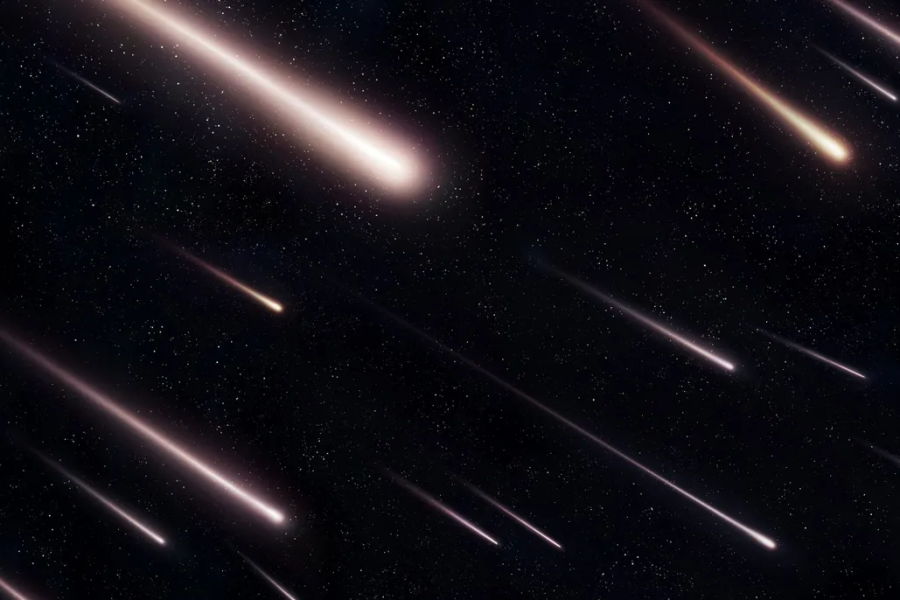
The night sky is about to erupt in a dazzling display of cosmic fireworks. Brace yourself, stargazers, for the Geminids meteor shower, one of the most awe-inspiring celestial events of the year, is upon us!
Peak Performance: This year’s Geminids peak on December 14th, reaching their maximum brilliance in the early morning hours, around 2:00 AM local time. However, meteors will be visible starting the evening of December 13th, so keep your eyes peeled throughout the night for a potential early show.
A Shower of Shooting Stars: Expect a celestial spectacle unlike any other. Under ideal conditions, you could witness up to 120 meteors per hour streaking across the night sky, leaving vibrant trails of light in their wake. This translates to seeing a meteor nearly every minute on average! The Geminids are renowned for their fast, bright meteors, often boasting fireballs and colorful explosions that add to the drama.
A Rendezvous with Phaethon: Unlike most meteor showers, the Geminids aren’t born from the debris of a comet. Instead, their source is the enigmatic 3200 Phaethon, a celestial object classified as an asteroid but exhibiting some cometary traits. Phaethon sheds dust particles along its orbit, which our planet encounters every December, resulting in the breathtaking Geminids display.
Optimizing Your Viewing Experience: To fully appreciate the Geminids’ celestial ballet, remember these key tips:
- Escape the city lights: Find a dark observation spot away from light pollution. A park, open field, or even your backyard can offer stunning views.
- Embrace the night: Allow your eyes to adjust to the darkness for at least 15-20 minutes. It’s worth the wait to see the faintest meteors.
- Lie down and look up: Reclining on a blanket or lawn chair will maximize your field of view, increasing your chances of catching meteors streaking across the sky.
- Be patient: While the peak night promises the most activity, meteors can appear throughout the night on both December 13th and 14th. Keep your eyes peeled and enjoy the show!
Beyond the Spectacle: Witnessing the Geminids isn’t just a visual treat; it’s a chance to contemplate the vastness of our cosmos and the cosmic dance of celestial bodies. Each shooting star is a tiny piece of space history, remnants of a mysterious asteroid streaking past Earth.
So, get ready to experience the magic of the Geminids. Whether you’re a seasoned stargazer or a curious newcomer, this annual cosmic light show is sure to leave you breathless. Don’t miss this awe-inspiring event – embrace the darkness, look up, and let the Geminids guide you on a celestial journey you won’t soon forget.
Remember, the best viewing conditions are away from light pollution, so head to a dark spot and prepare to be dazzled by the wonders of the universe!
Article above assisted by Google Bard, article below assisted by ChatGPT.
The Splendor of the Geminids: A 2023 Spectacle
Introduction to the Geminids Meteor Shower of 2023
The Geminids Meteor Shower of 2023 stands as one of the most spectacular astronomical events of the year. Renowned for its brightness and intensity, the Geminids originates from the asteroid 3200 Phaethon, making it unique among its counterparts that typically originate from comets. This article delves into the highlights and useful details of the Geminids Meteor Shower of 2023, offering enthusiasts and casual observers alike the information needed to fully enjoy this celestial display.
When and Where to Watch
The Geminids Meteor Shower graced the skies in December 2023, with its peak activity around the 14th of the month. Unlike other meteor showers, the Geminids can be observed just after sunset, though the best viewing times are typically after midnight. For optimal viewing, it’s recommended to find a dark location away from city lights, giving the eyes time to adjust to the darkness.
What Made 2023’s Geminids Special
The 2023 Geminids were particularly notable for a few reasons. Firstly, the absence of moonlight during the peak nights provided darker skies, enhancing the visibility of the meteors. Additionally, the meteor shower’s zenithal hourly rate (ZHR) was exceptionally high, with observers in ideal conditions witnessing up to 150 meteors per hour.
Tips for Meteor Shower Observation
Observing the Geminids Meteor Shower doesn’t require specialized equipment. A few tips for a better experience include:
- Dress Warmly: Nights can be cold, especially in December. Warm clothing and blankets are essential.
- Allow for Eye Adjustment: Spend at least 20 minutes in the dark to let your eyes adjust for optimal viewing.
- Comfort is Key: Bring a reclining chair or a blanket to lie on, as you’ll be looking up for extended periods.
- Patience Pays Off: Meteor showers are naturally variable, so patience is key.
Photographing the Geminids
For those interested in capturing the Geminids, a DSLR camera on a tripod with a wide-angle lens is ideal. Settings should include a wide aperture, a shutter speed of around 20-30 seconds, and a moderate ISO to avoid excessive noise. A remote shutter release can help prevent camera shake.
Environmental and Cultural Impact
The Geminids Meteor Shower not only offers a spectacular show in the night sky but also presents an opportunity for communities to come together for viewing parties and educational events. Additionally, this celestial event inspires a greater appreciation for our place in the cosmos and the importance of preserving dark skies from light pollution.
Conclusion: A Celestial Spectacle to Remember
The Geminids Meteor Shower of 2023 was indeed a remarkable event, offering a dazzling display of shooting stars that enthralled and captivated audiences worldwide. Its uniqueness, accessibility, and beauty make it a standout event in the astronomical calendar and a must-see for anyone interested in the wonders of the night sky.






